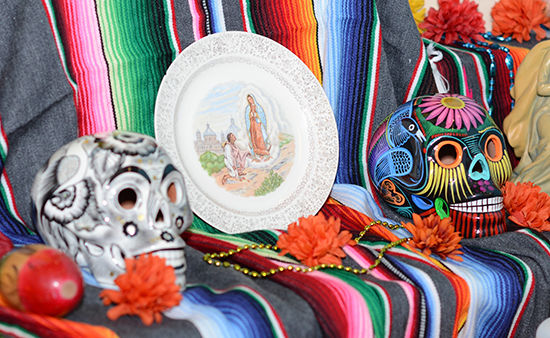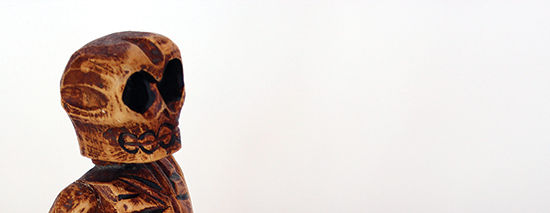Altars and Offerings
As part of their Day of the Dead traditions, families set up ofrendas (altars) in their homes and/or in public places to honor their deceased loved ones. Before the ofrenda is built, the house is thoroughly cleaned and a good table cloth is laid.

Levels of the Ofrenda
The levels used to build the ofrenda represent different stages of human existence. A two-level ofrenda represents earth and heaven. A three-level ofrenda includes purgatory. A seven-level ofrenda is the most traditional; it represents the necessary steps to rest in peace.
Four Elements
Ofrendas include the four classical elements:
- Earth – Represented by food such as pan de los muertos (bread of the dead)
- Wind – Represented by papel picado (paper banners) moving in the air
- Fire – Represented by a candle’s flame
- Water – Represented by a glass of water
Items on the Ofrenda
The family decorates the ofrenda with offerings that tell a story about their loved one’s life and help to guide their spirits home.
- Dog – Aztecs believe that a small dog serves as a guide and companion for the dead.

- Candles – Representing “fire,” one of the four elements of nature, a lit candle helps light the way for the spirit to return.
- Cross – In Aztec tradition, it symbolizes the four cardinal directions. In Christian tradition, it stands for death and resurrection.
- Flowers – When cut, flowers remind us that life is short. A loved one’s favorite flower is sometimes placed on their altar or grave. Marigolds are the symbolic “flower of the dead.” Paths of marigold petals combined with their strong smell help lead a loved one’s soul back.

- Food – Every altar displays a loved one’s favorite food and drink as a feast for the spirit to enjoy upon their return.
- Incense – The aromatic smoke of incense is used to help guide a loved one’s spirit home.
- Pan de Muerto (Bread of the Dead) – This traditional bread represents the souls of the dead and “earth,” one of the four elements of nature.
- Papel Picado (Paper Banners) – Colorful hand-cut tissue banners are placed around the altar and many other places during Day of the Dead celebrations. Their movement represents “air,” one of the four elements of nature.

- Photographs – A photo of the person being remembered is an important centerpiece of the altar.
- Salt – Salt is a purifying element that helps prevent decay during the journey.
- Skeletons – Skeletons represent the dead living on and carrying out their daily activities.

- Sugar Skulls – Sugar skulls are a traditional art from Mexico used to decorate altars and graves. The skull represents the loved one’s soul.
- Towel & Soap – A towel and soap are left on the altar for the spirits to refresh themselves after a long journey.
- Toys – Toys are used as offerings on altars dedicated to children who passed away.
- Water – A cup of water placed on the altar awaits a thirsty, travel-weary soul. It also represents “water,” one of the four elements of nature.

Further Exploration
Visit Day of the Dead Resources to find library books for kids and adults, downloadable/printable resources (like this Altar educational flyer), and additional websites to help you dig deeper into the origins and history of this magical celebration.